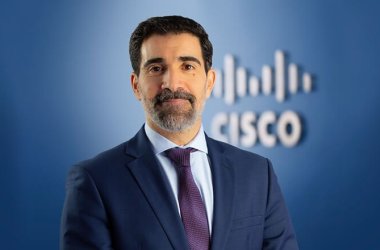
- Could you tell us more about Cisco Services?
The services business at Cisco involves professional services that help customers with kit design and implementation, to ensure they get maximum benefit and achieve the objectives they had in mind when they set out to purchase the kit. These professional services are sometimes initiated by Cisco alone and at other times in conjunction with our partners where we do part of the design or offer a part of these services to complement our partners.
The other side of the business revolves around the maintenance contracts that focuses on overall hardware replacement. We have an extensive depot pool both here and across the Middle East so our partners don’t necessarily have to stock kit themselves. We do that on their behalf provided they have a maintenance contract with us and that I believe this is one of our key differentiators.
The maintenance part of the services business is at this time the most exciting because it is evolving. This is where Cisco Smart Services come into play. One of the complaints I often hear, especially across the SMB space where coming up with capital cost is tough, is that customers or partners don’t see a benefit to a maintenance contract. This is only natural because you don’t see a benefit unless something breaks because only then does one get access to the Technical Assistance Centre, software updates or bug fixes. So if a network is coming along nicely a customer doesn’t see the benefit behind this upfront cost because they don’t need it. So what we are trying to do is evolve our services to be ‘smarter’, so there’s more proactive monitoring and health check within the services. That’s where the next generation of our maintenance services are going.
- How broad is the services arm?
Traditionally Cisco services have been broken up into ‘proactive’ and ‘reactive’ services.
The former revolves around network and security assessments, optimisation services, install base management, etc. These can be delivered by Cisco but we are actively encouraging partners to get involved.
The reactive services are focused on making sure the networks are healthy and will not fail. Cisco Smart Net Services gives customers the ability to call the Cisco Technical Assistance Centre directly for advanced hardware replacement, bug fixes, software updates etc.
There is a layer above Smart Net Services where customers can opt for Cisco to be directly involved in managing the network, which is the case with organisations in the critical infrastructure space such as national security, oil and gas, energy, transportation etc. These customers can avail a set of focused technical support services which is like the crème de la crème of Smart Net Services where Cisco is directly engaged with the customer who gets access to get access to a small set of engineers, a dedicated high touch engineer and an operations manager. A handful of our high end customers have that at the moment.
In the ‘Partner Led’ space we have what we call Shared Support and some regions are beginning to sell Cisco Collaborative Services, which is a derivative of the former. The difference between Smart Net and Shared Support is that in the case of the latter the partner is in the frontline whereas in the former the customer can directly contact Cisco. The fact is that in the case of Shared Support the contact interface is through the partner and only in unique cases where there is a hardware failure or if the partner cannot solve the problem, only then do we step in. The Cisco Shared Support Services fall on the maintenance side of the services business.
Cisco Smart Care is on that same side, the only difference is that instead of just having a maintenance contract, we are getting the partners involved in the proactive and optimisation side of services, which gets them closer to the customer who sees the business benefit to their maintenance contract which ultimately helps build a long term relationship and retain the customer. Customers of Cisco’s Smart Care contracts are happy with the reliability of their partners who share quarterly recommendations on their networks and systems and the renewal rates for Smart Care are very high.
On the professional services side we have recently launched the Cisco Collaborative Professional Services (CPS), which is strictly a partner driven business. One of the frequent requests we have from partners is that customers often want Cisco to endorse a design or have skin in the game, which is difficult, because we don’t typically endorse a design we weren’t involved in.
So this is a great solution because our advanced services for the SMB space tend to be expensive, but this is a compromise that gives partners and customers access to a centralised pool of resources. We have a group of engineers that are in Bangalore that deliver this service remotely who work with the partners on the design and assessments and they will endorse it. So in a manner of a speaking, this is a way for partners to leverage Cisco Advanced Services without having to pay the high cost of service delivery associated with it, more so for SMBs. This has really started to take off in and around the region. CPS gives the customers the assurance that Cisco is involved or the partners the security that there is another pair of eyes watching the design and operations. It helps boosts the partner’s standing in the eyes of the customer.
- How long has it been since you started talking about Smart Services and how much traction are you actually seeing from partners in that area?
Smart Care, for instance, which is associated with the SMB space, has been available to our 2 tier partners since 2008 but I would say we didn’t really start pushing it until last year. We have over 400 wins just in the UAE, so it has garnered significant interest.
CPS has seen slower uptake in the UAE as compared to the rest of the region but this is a greater focus area for me this year. Although the growth has been marginal, there has been growth.
With Smart Care I’m really happy because even though it has been available since 2008, we really only put the sales engine behind it this last year and have already witnessed over 50% growth this last year and there’s a lot of partners who have converted their Shared Support contracts to Smart Care Services.
- Are you targeting any particular vertical or business segments?
My responsibility is for the UAE and I cover all segments. What I will say is that I feel I have a huge focus on the SMB segment this year because from a services perpective we haven’t traditionally spent enough time in this space and that’s why I’m excited about some of the programmes such as Smart Care that really helps us drive joint solutions to the market together where the partner is leading but Cisco is there to support.
- So who are the right partners?
Cisco Smart Care is seeing the most traction from partners who want to establish a managed service practice or have an existing managed services practice and want to incorporate these services within their existing portfolio. These partners are now able to do much more than just upgrades and fixes or renew contracts; they can offer proactive monitoring, security and network assessments on a periodic basis.
I would say the right partner is one who really wants to get involved in the operational side of the customers business. If they’re a drop ship partner or a fulfilment partner this isn’t the right model for them. They need to be the kind of partners who want to develop an intrinsic relationship with the customers and want to be looked at as the customer’s potential IT arm.
The profile for the customer is ones that don’t have a huge IT budget or IT staff and therefore lack the excessive capabilities to manage a scalable network; typically customers should have 50-600 users or 5-105 devices which is about the same thing.
- What about training?
Depending on the service, we try and engage in trainings on a quarterly basis. In that we cover multiple services, it may just not be Smart Care but could also talk about Cisco Collaborative Professional Services. We also have online trainings and knowledge sharing portals, in addition we also engage partners via regular WebEx sessions to keep partners updated. It is a combination of face-to- face and WebEx trainings; we also have the business development team here who go out many times on a one to one basis and are more than willing to meet partners who are serious about getting involved in the services space.
Speaking of which we have a WebEx coming up on the new launch of Smart Care 1.9, we have changed the way we are praising it and quoting it because earlier partners depended on us for the quote, this reduces the lead time and empowers them to work out the best quotes which we see as vital for the uptake of these services. We also have a great services training that is available for our partners. It is a 2-day comprehensive online training that will discuss all our service offerings called the Cisco Service Expert Programme. The training will also talk about a test that partners can take to attain this certification.
- Partners often say that customers don’t understand the additional price that they need to pay for a service and expect it to be a bundled offer, how are you helping partners address this?
This is one of the challenges we had with Smart Care initially, but the 1.9 release introduces an SKU based approach, similar to Shared Support or Smart Net so partners have the ability to package the best services and come up with creative quotes for their customers.
We believe that this is one step in that direction and it is a good idea to look at developing a programme that wraps our services arm around our hardware or product sales.
- Have you launched any incentive programmes in this area?
Yes of course. There is a services component to the new Partner Plus Programme. It provides incentives for partners who are focused on the mid-sized partners. There are product and service rebates associated with this new programme, tied to revenue growth targets. It is an invitation only program for FY13 and will be opened to Gold, Silver, Premier and top performing select partners.
We have also announced a new Services Programme that will not be available in the region until the October of FY 14. This is a rewards driven program with a big Smart Services component to it, so partners who are aware and understand the benefits of Smart Services will have an easier migration to the new program and will be ahead of the game. It will not be a mandatory part of the program but it is an incentivised option. This is one of the reasons why I’m trying to drive the focus this year so that we are not starting from scratch in FY 14 and a fair share of our partners are ready to reap the benefits of the new programme.
- What are the plans for the next 12 to 18 months?
We’re working on some incentives for partners to drive the business and will be announcing these over the next quarter or two. We are also working with distributors, particularly for the 2 tier space to get the word out there, so we’re looking at joint events in the UAE to spread the word.
My objective is to have at least quarterly training and awareness sessions around Smart Care, CPS or what we call ‘Partner Led Service Programmes’ in addition we will continue with the WebEx and will continue to send our business development teams out there to share the knowledge.
I am excited about this year and ready to go to market with our partners for Cisco Services because for the first time in a long time we have programs in place to help drive the business, for partners and customers alike. So this year is all about Smart Care and CPS for me. //





